For a dispassionate, non-partisan assessment, I would suggest tracking the Quarterly and Annual Reports put out by the Market Surveillance Administrator (MSA).
In the Q1 2023 report, they outline a combination of factors that require addressing if Alberta is going to continue putting more VRE generation on the system.
Yes, the congestion and storage requirements are problems, but perhaps the largest problem is how we handle forward pricing.
Generators are permitted to set their own price on providing the stabilizing power required to balance a renewable heavy grid. And we ain't even that renewable heavy yet!
"The ability of companies to exercise market power was lower in Q1 2023 relative to Q3 2022 and Q4 2022, in part because of mild temperatures and increased wind and solar generation. Some larger suppliers continued to exercise market power in Q1 2023.
One supplier withheld a large amount of capacity by pricing it above $900/MWh regardless of market conditions. Another supplier
generally offered large amounts of capacity between $700 and $900/MWh when market conditions were tighter."
[...]
"As documented previously in this section the increase in wind and solar generation means that:
• there will be higher ramping requirements in the future,
• there will be more thermal generation capacity commercially offline, and
• larger wind and solar forecast errors will occur more often.
As a result,
the scale of investment in wind and solar generation has implications for how efficiently resources are allocated in the electricity market under the existing ISO rules."
[...]
"This calls into question whether the existing ISO rules, which were developed in the past based on the prevailing understanding and expectations, remain ideal in the face of changing technology. As a general matter,
there is no reason why they need to be so and the flexible nature of the electricity market, including the ability to change these rules within the market construct itself, makes plain that
some degree of change and adaptation is expected to occur.
As documented above,
the production profile of wind and solar generation impacts the nature of the net demand that must be satisfied by other generators. These impacts are readily visible in the electricity market and will grow in the future.
In the short run (
when installed generation capacity is effectively fixed), wind and solar capacity lowers the pool price when it is producing. However,
this impacts the commitment decisions that large thermal generators make on a day-to-day basis which affect sequences of hours irrespective of realized wind and solar production.
The reduction in committed thermal supply can offset the impact of additional wind and solar production, though disentangling this effect from the exercise of market power is not a trivial undertaking."
MSA Q1 2023 Report (105 pages, mixed text & graphs)
MSA Q1 2023 Presentation (47 Slides)
It's pretty simple.
The lowest cost kWh in the system is NOT the marginal unit. The marginal unit is the NEXT UNIT REQUIRED. When we allow the supplier of that unit to have discretionary control of when to release capacity into a system signaling demand, how is anyone on earth shocked that the supplier will choose to wait a little and withhold their stuff until a buyer is willing to pay infinity dollars?
Like someone said, these aren't potatoes that you just go to another store for. These are the guys on the side of a road in a heat wave or evacuation, charging $250 for a bottle of water.
And guess what, this gets worse as the duck curve gets deeper. Alberta has it's own duck now. When you factor in the capacity that is in application queue, it resembles California. (Slides 12 & 15).
Costs up.
Emission Intensity flat.
Land use way up.
Sorry, but I'd rather have a society that recognizes energy as the base currency and primary input into the entire machine. I don't give a flying F that a small handful of generators and line owners get to make insane returns if that means that people suffer in normal conditions, die in severe conditions, and everyone downstream who uses the power to DO THINGS is doing less total, and the output they do perform has lost a tremendous amount of relative value. Those producers can and will leave. This is a severely BAD trade.

The moratorium is necessary. Not because of the rebuildables themselves, but because the system is busted in a way that allowing the in queue projects online will have a severe impact in the short term. That bleeding needs to stop.
But the fun won't end there. It's demonstrable that this is the effect high VRE penetration has on markets of all types. MOST markets experience increases in real household prices when VREs are built out. MOST VRE buildouts never exceed ~35%, which seems to imply some kind of practical limitation.

AND, best of all... All of this over a tiny SLIVER of our actual fuel type consumption. We barely use any electricity at all in this province, compared to the elephant in the room: natty. Electricity is roughly 274 PJ annually, natural gas is 10x that at 2,340 PJ. Refined pet products clock in the middle at 1,370 PJ.
Good times!